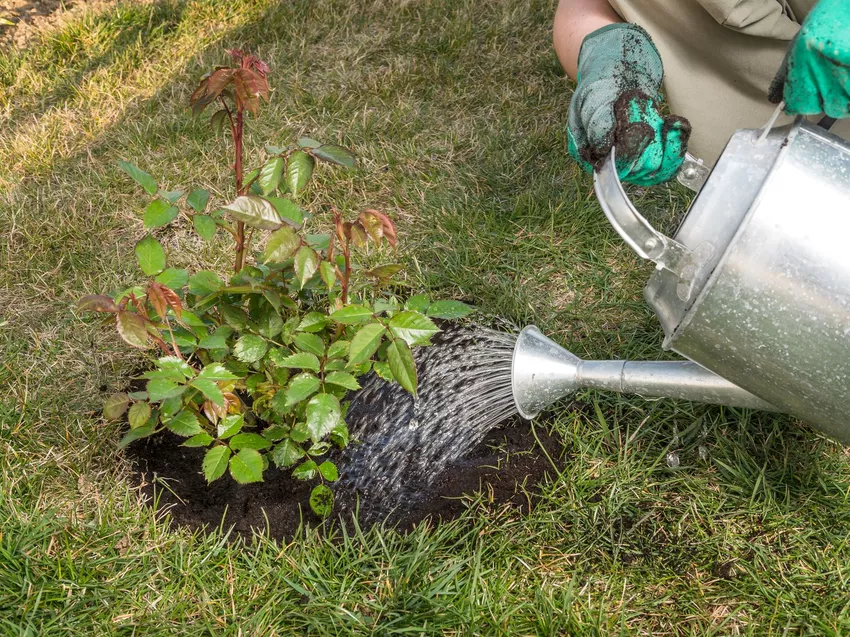Only those who take good care of their roses will be rewarded with beautiful flowers. Here's everything you need to know about caring for roses - from pruning to fertilizing.

Roses (Rosa) should not be missing in any garden or on any balcony, because in summer the pretty flowers are a real eye-catcher. But only a he althy rose that feels good all round will reward you with a rich bloom. In addition to regular watering and fertilizing, the right pruning of roses is particularly important for successful cultivation. In areas with a harsh climate, you should also use frost-hardy varieties and, if necessary, take special protective measures so that your rose gets through the winter well. If you follow a few basic rules when caring for your rose, it will certainly thrive and unfold its full bloom.
In the following we explain how to water, fertilize and cut your roses correctly. We have also summarized the most important points for overwintering roses and caring for roses in pots.
Watering the roses
Roses don't like it too dry or too wet. It is therefore best to choose a sunny, airy location for your darling so that moisture does not build up and the development of fungal diseases is prevented. It is also best to water your rose early in the morning and make sure not to wet the upper parts of the plant with water. Young rose plants in particular need to be watered regularly. The soil of older plants should always be moist. In our special article we explain what else you need to consider when watering roses.

Pruning Roses
It is best to do the basic pruning of roses in spring (March/April) before the new shoots. The strength of the pruning depends above all on the growth form of the roses. For example, weak-growing bed roses should be cut back to three he althy shoots with three eyes. In the case of strong-growing bed roses, you can leave about five shoots with five buds each. Minor cutting measureswilted flowers and broken shoots can be removed from roses even during the growing season. It also makes sense to remove diseased parts of the plant to prevent the spread of fungal diseases. General rules for pruning roses as well as precise instructions for pruning climbing roses, standard roses etc. can be found in our special article.
Fertilize roses
Roses are among the heavy feeders, which is why regular fertilization is essential. A first fertilization in spring (March/April) with compost or an organic long-term fertilizer such as our Plantura organic rose fertilizer specially developed for roses supports the plant in its new growth. A second fertilization can then take place at the beginning of the flowering phase at the end of May. Rose varieties that bloom more often receive a final fertilization during the main bloom period in early July. However, later in the year you should not use fertilizer so that the newly formed shoots mature by winter. Ideally, you should use a long-acting organic fertilizer for your roses. This is slowly decomposed and thus provides your rose with sufficient nutrients over the long term. In our special article, we explain in detail how best to proceed when fertilizing your roses.
Winter roses
In order for your rose to get through the winter well, a few protective measures must be taken. It is best to apply the winter protection only when a frost period is in prospect. Also, remove old inflorescences and leaves beforehand. And the leaves on the ground should also be removed. Then pile up the earth about 20 cm high and put fir green between the shoots. Special garden fleece, jute bags and bamboo mats are also available for insulating standard roses. To ensure that nothing goes wrong when storing your roses over the winter, you will find detailed instructions in this article.
Caring for roses in pots
Smaller roses with a compact habit can be cultivated in pots on the balcony or terrace. Compared to exposed specimens, potted roses require a relatively large amount of water. When the substrate has dried out on the surface, it is high time to water. In order to avoid waterlogging, it is best to put in a drainage layer made of potsherds or expanded clay when planting. For a sufficient supply of nutrients, it is best to give your rose liquid fertilizer with the irrigation water every two weeks. If, on the other hand, you prefer to use a long-term fertilizer, two to three doses over the course of the year are sufficient.

In winter, the roots in particular need special protection. It is therefore best to place the pot on a styrofoam sheet to avoid direct contact with the ground and wrap it in a thick layer of insulation material. If no permafrost is to be expected, your potted rose can simply overwinter in a sheltered place outdoors. We have put together further information on the subject of "roses in pots" for you here.
If you have read this article, you are already well prepared and can support your rose in its development with optimal care. If you still haven't had enough, you can find out exactly how best to proceed with the care of climbing roses here.